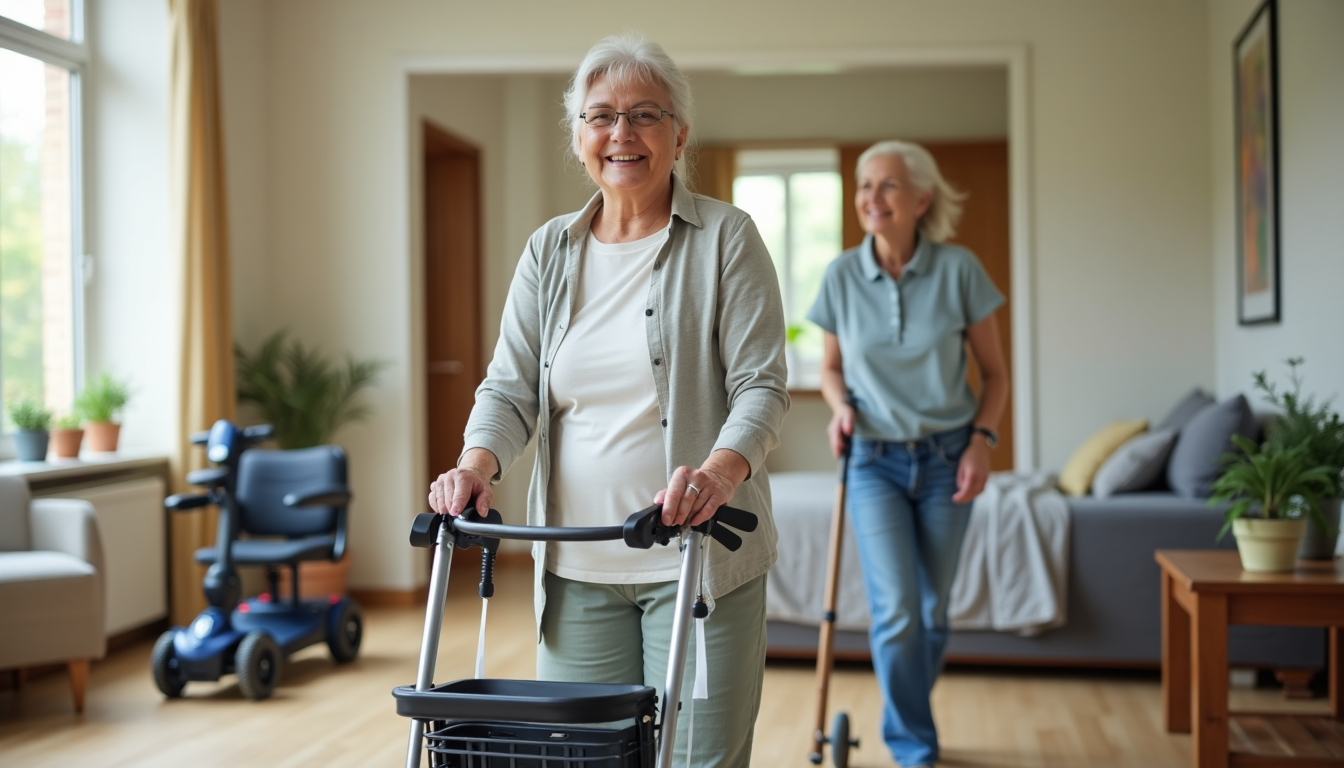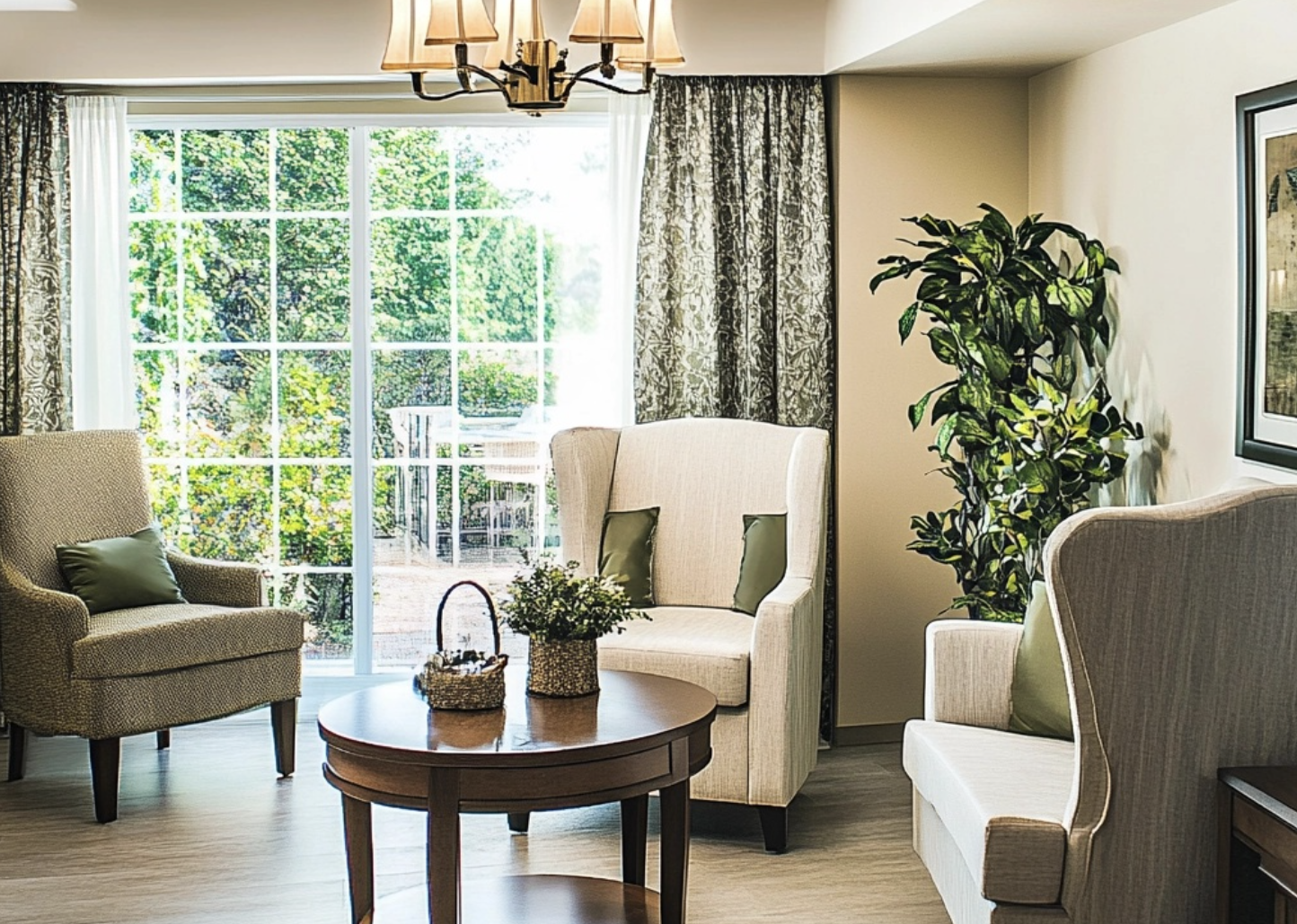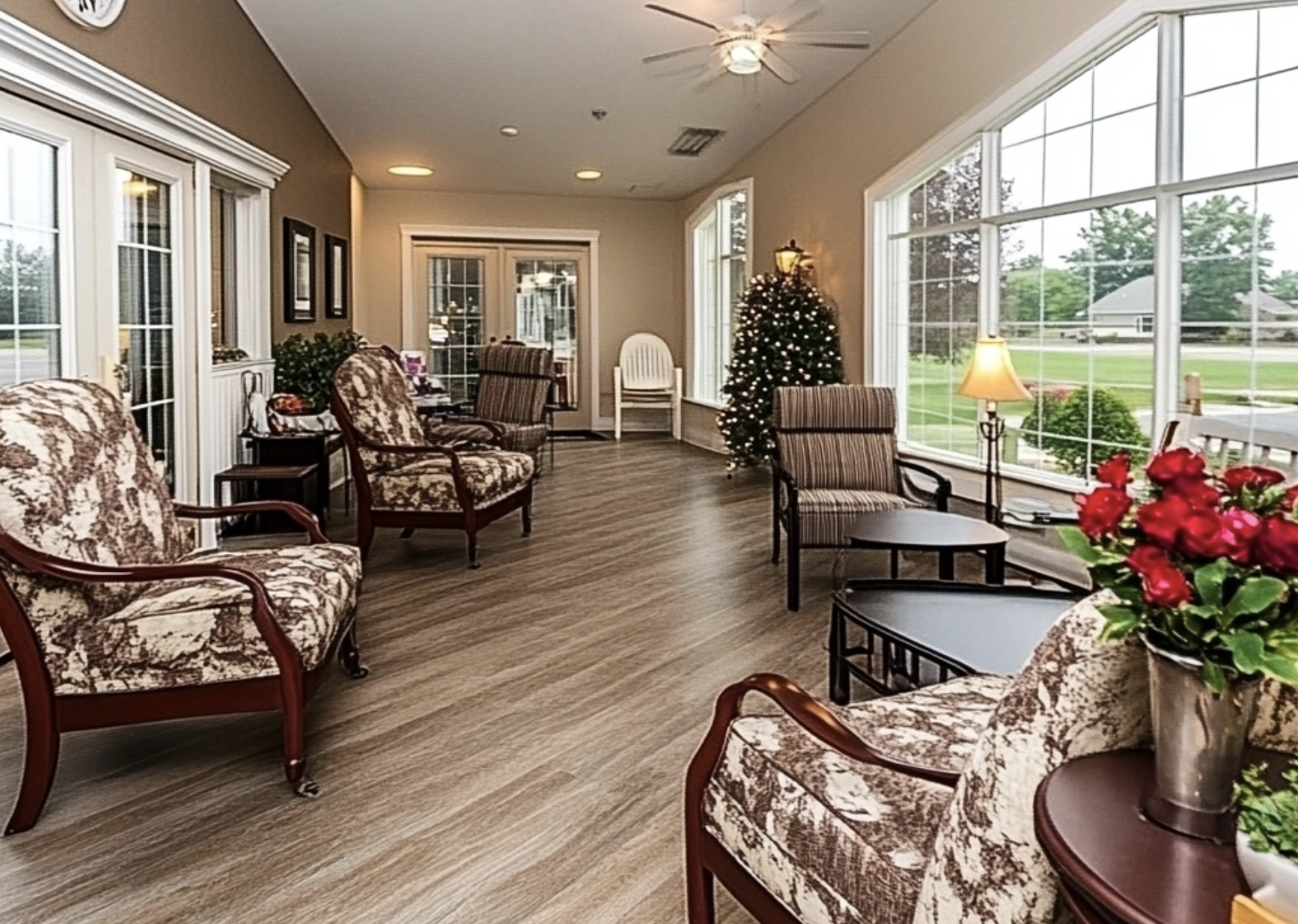Falls among seniors cause moderate to severe injuries in 20-30% of cases, making assistive devices for elderly individuals potentially life-saving rather than merely convenient accessories.
Statistics show that over 20% of seniors already use mobility aids for walking to maintain their independence. These devices have proven effective at reducing fall-related injuries while simultaneously improving balance and mobility. Nearly 30% of adults 65 and older currently use health aids for elderly care in both indoor and outdoor environments.
The technology behind assistive devices for elderly users continues advancing rapidly. Modern walkers and wheelchairs now feature lightweight frames engineered specifically for smoother maneuverability. Advanced electric scooters include customizable speed settings and anti-tipping mechanisms for enhanced safety. The right assistive device significantly improves quality of life by increasing independence and enhancing the ability to perform daily activities.
We tested dozens of options to compile this guide to the 15 best assistive devices for elderly users in 2025. Our evaluations range from basic canes to smart hospital beds that automatically adjust to prevent bedsores. Each device received ratings based on effectiveness, price, and ease of use.
Walking Sticks
Walking sticks rank among the most versatile mobility aids for walking, offering crucial support for seniors maintaining independence. Modern walking sticks blend functionality with personalization options, contributing to their growing popularity among elderly individuals needing reliable support.
Walking sticks for elderly support
Walking sticks provide excellent balance and stability, making them essential health aids for elderly individuals experiencing unsteadiness. These devices redistribute weight and create additional ground contact points, reducing strain on knees, hips, and ankles.
The material selection significantly affects performance. Premium woods like hickory withstand strenuous conditions while offering shock resistance, whereas cedar delivers a lightweight yet functional alternative. Seniors with joint issues benefit from materials like sassafras, which combines rustic appearance with practical support. Pine remains considered one of the best options specifically for elderly users.
Walking sticks fundamentally differ from standard canes. While canes support only one side of the body, walking poles deliver balanced support through both arms, preventing posture imbalances that might develop with single-point assistance.
Walking sticks pricing and adjustability
Quality walking sticks typically cost between $100-120 for high-grade aluminum alloy models. Carbon fiber options cost more but offer minimal practical advantage for most seniors, as aluminum provides superior durability and resilience.
Adjustability remains essential for elderly users. Premium models feature flip-lock mechanisms that securely adjust heights from 32″ to 54″, accommodating users up to 6’2″. This adjustability allows seniors to customize their walking sticks based on terrain—longer for uneven surfaces and shorter for flat ground.
Best walking sticks for 2025
The York Nordic Motivator leads the market as one of the top assistive devices for elderly users in 2025. Trusted by physical therapists, these poles feature patented contoured grips with dual support zones specifically designed for balance improvement.
TrailBuddy Adjustable Trekking Poles excel with comfortable cork handles that mold to hands in various weather conditions, making them particularly suitable for seniors with arthritis or limited hand mobility.
Black Diamond Trail Back walking sticks, constructed from aero-grade aluminum alloy, balance durability and weight effectively. Their secure locking mechanism prevents dangerous slippage during use, a critical safety feature for seniors.
Rollators
Rollators represent a significant advancement in mobility assistance compared to more basic devices. These four-wheeled walkers offer superior stability for seniors who need reliable support without sacrificing independence.
Rollators for mobility and balance
Rollators excel at providing balance assistance for elderly individuals with moderate mobility challenges who maintain good coordination. Most feature aluminum frames supporting between 250-300 pounds, with some bariatric models accommodating up to 400 pounds. Their design encourages a more natural walking posture than standard walkers, reducing strain on the back and shoulders.
The wheel configuration significantly impacts performance. Four-wheeled models offer maximum stability, while three-wheeled designs provide exceptional maneuverability in tight spaces. Front wheels ranging from 8-10 inches handle various terrains smoothly, making rollators suitable for both indoor and outdoor use. Most include hand brakes that work when squeezed or pushed down, ensuring safety during movement.
Rollators with seats and storage
Nearly all four-wheeled rollators include cushioned or mesh seats, perfect for seniors who need occasional rest breaks. Padded seats with backrests provide superior comfort for extended sitting. Models like the NOVA Express include removable curved backrests that support proper posture.
Storage options remain essential for practical use. Most rollators feature under-seat pouches or baskets for carrying personal items, medications, or shopping goods. Some premium models even offer additional saddle bags or detachable storage compartments.
Rollator pricing and portability
Rollator prices typically range from $50 to $500, depending on features and materials. Mid-range models ($100-250) generally provide the best value, offering larger wheels and requiring minimal assembly. Premium options incorporate lightweight materials, advanced braking systems, and enhanced comfort features.
Portability proves crucial for seniors on the go. Most quality rollators fold easily for transport, though they generally weigh between 11-30 pounds—significantly heavier than standard walkers. Their ability to fold compactly makes them suitable for storage in car trunks or closets.
Standard Walkers
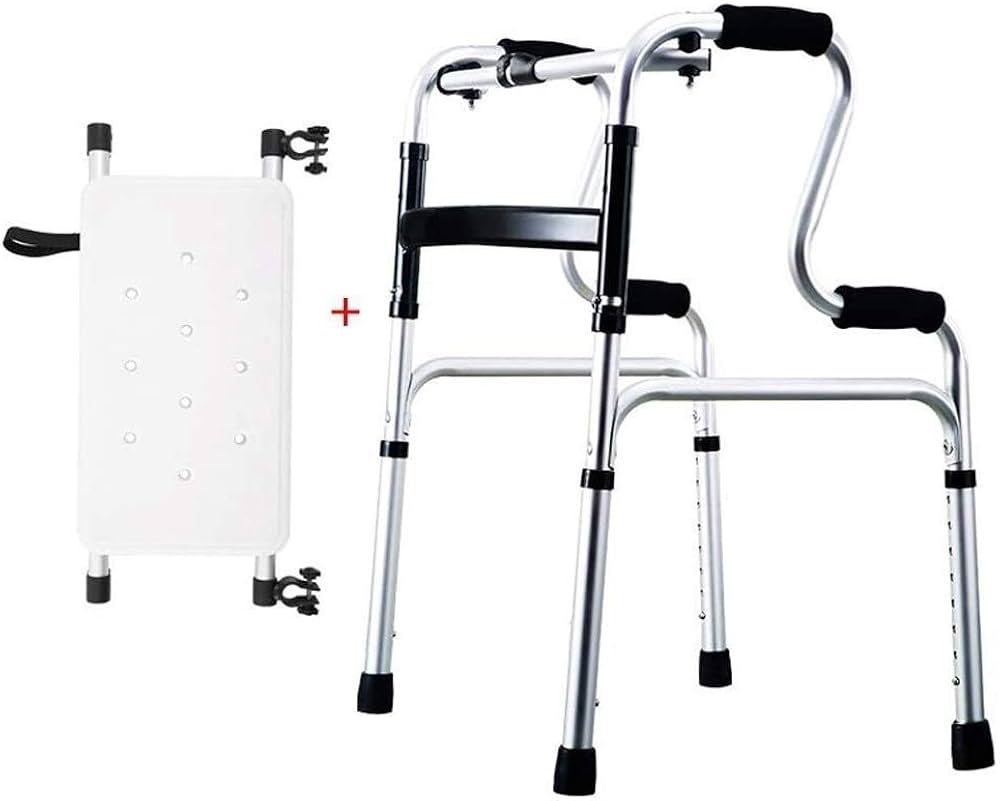
Standard walkers provide maximum stability for elderly individuals who need reliable support for safe movement. These lightweight frames offer exceptional security for seniors with significant balance issues, making them vital medical equipment for seniors recovering from surgery or managing ongoing mobility challenges.
Standard walker benefits for seniors
Standard walkers are available in two main variations. The classic “four-point” walker features rubber-tipped feet requiring lifting between steps, delivering exceptional stability for those with serious balance concerns. Two-wheeled walkers include front wheels with rear rubber tips, allowing users to slide the walker forward for a more natural walking pattern.
These devices offer several key advantages for elderly users. They increase independence and self-sufficiency, helping seniors safely navigate their environments. Standard walkers also promote exercise, building strength and endurance while providing opportunities for continued socialization. The devices significantly reduce fall risks by offering sturdy support during movement.
Best standard walkers for home use
The Drive Medical Deluxe Folding Walker stands out as a leading option, weighing only 7 pounds with its lightweight aluminum frame. Its two-button folding mechanism makes it easy to store and transport. The Medline Folding Trigger Walker provides specialized support for Parkinson’s patients while accommodating users up to 300 pounds.
For heavier individuals, the Medline Adult Heavy-Duty Folding Walker supports up to 400 pounds with its reinforced frame. The Stander EZ Fold N’ Go Walker Lite combines portability with impressive capacity, supporting users between 4’10” to 6’8″ tall with a 400-pound weight limit.
Walker pricing and durability
Standard walker prices typically range from $40 to $125, with variations based primarily on durability, weight capacity, and special features. Most models feature height-adjustable aluminum frames that accommodate users between 5’4″ and 6’2″ tall. Customization options include ski glides, felt pads, tennis balls, or fixed casters to improve mobility across different floor surfaces.
Canes
Canes stand as the most widely used mobility aids for walking, offering elderly individuals a balance of simplicity and effectiveness. These devices provide targeted support while remaining portable and discreet compared to other assistive options.
Types of canes for elderly
Several cane varieties address different mobility needs. Single-tip canes serve as the most common option, ideal for seniors needing minimal balance assistance. For those requiring greater stability, quad canes with four-point bases provide broader support, particularly beneficial for stroke recovery patients.
Handle design significantly affects comfort and functionality. Options include:
- Standard grips – Simple wooden or plastic handles
- Ergonomic grips – Contoured to fit hands naturally, reducing strain
- Offset grips – Feature forward-bending handles that align weight over the cane shaft
- Palm grips – Distribute pressure evenly across the palm
Adjustability proves crucial for proper fit. With adjustable height settings, seniors can customize their canes to match their specific body dimensions, ensuring the elbow bends at a comfortable 15-20 degree angle.
Canes for balance and posture
Proper cane usage improves stability substantially. When fitted correctly, canes support up to 25% of a person’s weight, making them effective medical equipment for seniors with joint discomfort.
Specialized posture-correcting canes change the user’s line of sight from downward to forward, promoting upright walking that reduces spinal strain and improves overall balance. This adjustment benefits long-term users who might otherwise develop postural issues.
The cane should be held in the hand opposite the weak or injured leg, moving in tandem with that leg to provide support during each step.
Affordable cane options
Cane prices vary based on materials and features, yet remain among the most economical health aids for elderly individuals. Basic wood canes offer classic styling with prices starting around $25, while aluminum models with adjustable heights typically range from $30-40.
Folding canes combine portability with style, generally priced between $25-50. These collapse easily for storage in bags or purses when not in use.
Premium options with specialized features like self-standing capabilities or ergonomic grips may cost between $35-100, delivering advanced comfort and stability.
Wheelchairs
Wheelchairs provide essential freedom and independence for seniors needing comprehensive mobility support. These devices come in various configurations to address different mobility challenges and lifestyle needs, making them vital medical equipment for seniors with limited mobility.
Manual vs. powered wheelchairs
Manual wheelchairs require physical propulsion by either the user or a caregiver. They excel in portability and affordability, with prices typically ranging from $50 to $500 depending on features. These lightweight options are easier to transport and have fewer moving parts requiring maintenance. Seniors with sufficient upper body strength or those who regularly have assistance find manual models most suitable.
Power wheelchairs operate via battery-powered motors controlled through joysticks. They require minimal physical effort, making them appropriate for elderly individuals with limited strength. These electric models can travel 4-8 miles per hour and handle various terrains including rough surfaces and inclined slopes with ease. Despite these advantages, power wheelchairs are heavier, costlier to maintain, and require regular battery charging.
Wheelchair comfort and customization
Modern wheelchairs feature significantly advanced comfort elements. Electric models often include adjustable seating positions, cushioned seats, and suspension systems for extended use. Many offer recline and tilt options specifically designed for pressure relief.
Customization options address individual user needs. These include adjustable seat width and depth, various wheels and casters, and different armrest styles. Some manufacturers offer personalized paint jobs and tailored upholstery to enhance independence and individuality. Specialized frames accommodate different requirements, with bariatric versions supporting higher weight capacities.
Wheelchair pricing and insurance coverage
Price differences between wheelchair types reflect their complexity. Manual wheelchairs generally cost between $50-$500, while electric models range from $2,000 to $15,000. This substantial gap stems from the motors, batteries, and electronic systems in powered versions.
Medicare Part B covers wheelchairs deemed medically necessary. After meeting the $257 deductible (2025), Medicare pays 80% of the approved amount. Qualifying seniors must have a condition causing significant difficulty moving at home and be unable to perform daily activities without a wheelchair. The process requires a face-to-face examination and written prescription from a treating provider. Private insurance coverage varies, making it advisable to check plan specifics before purchasing.
Mobility Scooters
Mobility scooters provide elderly individuals with independent transportation options beyond what traditional mobility aids offer. These devices bridge the gap between manual mobility aids and full-sized vehicles, delivering greater range and comfort for seniors seeking autonomy.
Mobility scooters for outdoor use
Outdoor mobility scooters feature different configurations suited to various environments. Four-wheel models deliver superior stability through a broader wheelbase, making them appropriate for uneven terrain. Three-wheel versions allow tighter turning radiuses when navigating crowded spaces. Specialized all-terrain scooters come equipped with oversized tires designed to handle challenging surfaces including gravel, sand, and grass.
Weather protection enhancements expand outdoor usability significantly. The Cabin Car model offers full enclosure against rain, featuring heated interiors, windscreen wipers, and lockable doors. More basic canopy attachments provide essential shelter without complete enclosure, suited for variable weather conditions.
Top mobility scooter features
Key features include adjustable seating with forward/backward positioning options and swivel capabilities that simplify mounting and dismounting. Most models incorporate storage solutions such as baskets, under-seat compartments, and saddle bags for personal items and shopping needs.
Battery performance differs considerably between models. Standard batteries typically deliver 10-25 miles per charge, while premium options extend range up to 45 miles. Speed capabilities range from 4-5 mph in basic models to 18 mph in performance versions.
Safety features require careful evaluation, including headlights, taillights, turn signals, and reflective elements for visibility. Higher-end models incorporate anti-tip wheels that provide additional stability on difficult terrain.
Mobility scooter cost and maintenance
Pricing varies by category: travel/portable scooters cost between $600-$1,500, mid-size models range from $1,000-$3,000, and full-size versions run $2,000-$5,000. Maintenance typically requires professional servicing every 3-6 months, costing $50-$200 per visit.
Battery replacement constitutes the primary ongoing expense. Standard sealed lead-acid batteries last 18-24 months and cost $50-$150, while lithium-ion batteries provide up to 5 years of service but cost $100-$500.
Bed Rails
Bedroom safety represents a critical yet often overlooked aspect of elderly care. Bed rails serve as essential assistive devices for elderly individuals facing mobility challenges during rest hours.
Bed rails for fall prevention
Getting in and out of bed ranks among the top reasons for falls among seniors, making bed rails crucial preventative tools. These simple barriers drastically reduce nighttime accidents by creating physical boundaries that prevent rolling or sliding out of bed. Recent safety studies show properly installed bed rails can lead to approximately 30% reduction in falls.
Bed rails encourage self-reliance by offering stable support for repositioning in bed. Seniors can independently adjust their posture, sit up, or transition from lying to sitting without caregiver assistance. This independence fosters confidence and promotes aging in place—allowing elderly individuals to remain in their homes longer.
Best bed rails for elderly safety
Several bed rail types address different needs. Traditional fixed rails provide permanent safety solutions, while adjustable models offer height and length customization. For seniors requiring extra support, half-length rails on both sides of the bed are often recommended over full-length versions to minimize entrapment risks.
Bed rails with swing-away arms provide added flexibility when getting in and out of bed for those needing mobility assistance. These specialty rails typically cost around $123 and include adjustable features for personalized use. Premium options like the Step2bed incorporate padded grab bars and motion-activated LED lights to prevent nighttime accidents.
Bed rail installation and pricing
Installing bed rails involves straightforward steps: positioning the rail against the bed frame, securing it with brackets or clamps, adjusting to appropriate height, and conducting safety checks. Verifying compatibility with your specific bed type is essential—standard residential beds often require different rail systems than hospital beds.
Price points range from $40 for basic models to $500+ for premium options with advanced features. Mid-range prices ($100-250) typically offer the best balance of quality and affordability. Following manufacturer instructions during installation remains crucial—improper setup can create dangerous gaps between the mattress and rail.
Bathroom safety stands as a critical concern for elderly individuals, with grab bars serving as essential assistive devices that reduce fall risks in one of the home’s most hazardous areas.
The bathroom presents unique dangers due to slippery surfaces and the complex movements required during bathing and toileting activities. Properly installed grab bars provide stable support points that significantly reduce the risk of slips and falls in wet environments. These fixtures offer reliable handholds for transitioning between sitting and standing positions while enhancing independence by allowing seniors to manage bathroom activities without constant assistance.
Strategic placement proves crucial for maximizing effectiveness—near toilets for sitting/standing support, in showers for entry/exit assistance, and along walls where balance might be compromised. Research indicates bathroom grab bars have reduced physical effort required by caregivers during transfers by approximately 40%, making them valuable health aids for both elderly individuals and their support networks.
Several grab bar varieties address different mobility needs:
- Vertical bars (33-36 inches high): Better suited for standing positions such as shower entry/exit
- Horizontal bars (18 inches from corner): Ideal for lowering or raising the body
- Angled bars: Combine benefits of both vertical and horizontal support
- Swing-up bars: Designed for compact spaces like toilet areas, can be folded away when not in use
Materials and finishes have advanced significantly in recent years, with manufacturers like Moen, HealthCraft, Delta Faucet, and Safety 1st leading the market. Modern designs integrate seamlessly with bathroom décor, offering options in brushed stainless steel, matte black, and decorative patterns that maintain aesthetic appeal without compromising safety.
Installation must follow specific safety protocols for maximum effectiveness. Grab bars should be anchored directly into wall studs to ensure they can support a person’s full weight. When installing during renovation, adding wood backing behind shower walls provides flexibility for future bar placement.
Vertical bars should be positioned 18 inches from corner walls, while horizontal bars work best at 33-36 inches above the floor. Height customization remains essential, with placement based on the user’s physical dimensions and specific mobility challenges. Maintaining proper clearance between the bar and wall (minimum one inch) ensures adequate grip space, preventing accidents caused by insufficient hand room.
Rising Aids
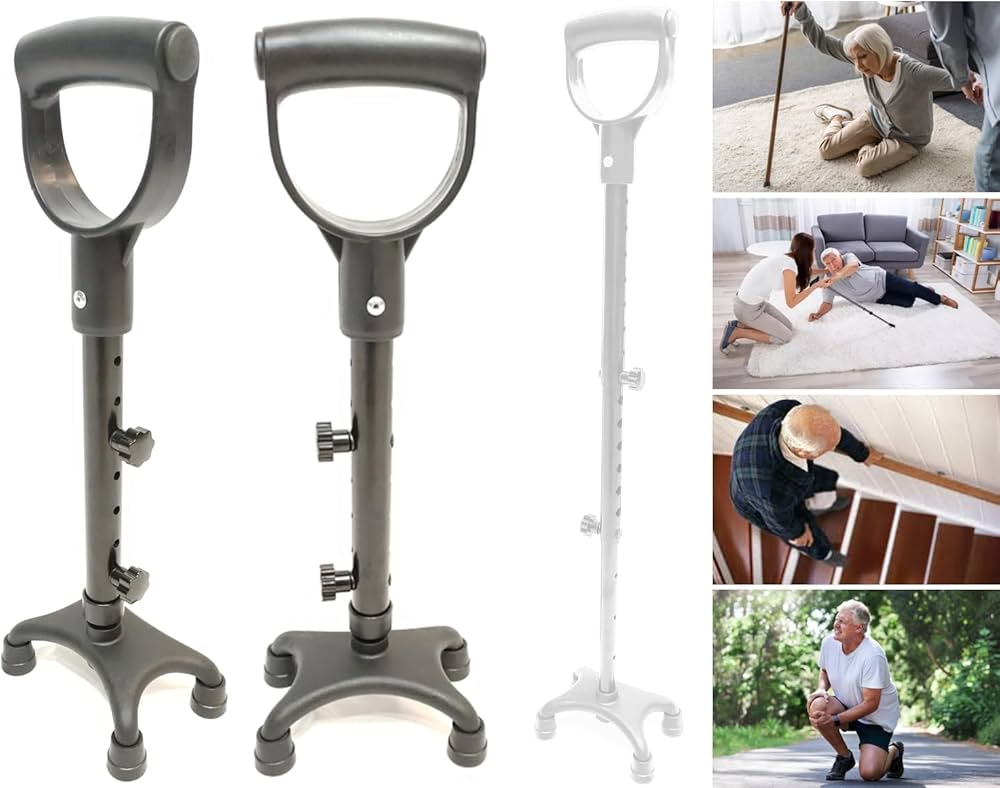
Rising from a seated position presents significant challenges for many elderly individuals. Specialized rising aids serve as essential medical equipment for seniors with reduced mobility or joint pain, restoring independence for daily activities.
Rising aids for standing support
Rising aids help seniors transition from sitting to standing positions—a movement that becomes difficult due to reduced muscle strength, arthritis, or other health conditions. These specialized tools provide crucial support while maintaining dignity for those with weakness in lower limbs or joint pain from conditions like arthritis.
Several types address different mobility needs:
- Electrical cushions – Powered assistance that gradually lifts users
- Spring-loaded devices – Mechanical support using internal mechanisms
- Inflatable cushions – Adjust support level through air pressure
- Leverage-based tools – Provide stable grip points for manual rising
These devices work by cushioning weight as seniors sit down, then providing upward assistance when they stand again. Some options use internal hydraulic arms offering gradual, supported movement throughout the entire sitting-to-standing process.
Top rising aids for 2025
The Handy Handle ranks among the most affordable yet effective options, providing simplified leverage for rising from couches, cars, and chairs. The Assist-A-Tray combines a standing handle with a convenient side table, offering dual functionality.
For more comprehensive support, the Stand Assist by Vive delivers stable assistance for those rising from chairs, sofas, and recliners. The Signature Life Sure Stand Security Pole offers adaptable installation options—even working with slanted or vaulted ceilings up to 12 feet.
Premium options include the Uplift Premium Power Seat, providing up to 100% electric lift assistance. The Carex Upeasy Seat Assist offers economical portable lifting support.
Rising aid affordability
Pricing varies significantly based on complexity. Simple standing aids like chair raisers typically cost around $43.99, while manual assist handles average $21.99. More sophisticated options like lifting cushions range from $119.99 to several hundred dollars depending on features and lifting capacity.
These devices represent excellent value for maintaining independence, often proving more cost-effective than home renovations while fulfilling similar accessibility needs. Some insurance companies and senior care non-profits may partially cover costs for medically necessary equipment.
Transfer Aids
Transfer aids help elderly individuals move safely between surfaces, preventing falls during critical transition moments. These specialized devices bridge mobility gaps when changing positions poses significant risk.
Transfer boards function as bridges between two surfaces, allowing seniors to slide across rather than attempting to stand and pivot. Most quality boards are made from either sealed lightweight wood or durable plastic with smooth surfaces to reduce friction. Manufacturers typically include tapered ends for easier transfers and hand slots for secure grip during movement.
Patient lifts provide comprehensive support for those with minimal mobility. Manual lifts like the traditional Hoyer operate via hydraulic mechanisms and cost between $600 to $3,000. Electric alternatives offer button-operated functionality ranging from $900 to $9,500. Ceiling-mounted systems with overhead tracks typically run from $4,000 to $14,000.
According to the CDC, transfer aids significantly reduce physical strain for caregivers while lowering patient fall risks. Gait belts wrapped around a patient’s waist give caregivers better leverage during transitions. Many transfer slings feature multiple padded handles for maintaining proper grip throughout the entire transfer process.
Proper technique remains essential even with assistive equipment. The CDC recommends transfers should be safe for patients, allow them to assist when possible, and minimize physical demands on caregivers through good body mechanics.
Pricing varies substantially across categories. Simple transfer boards start around $68, while advanced systems like the PPS Glide Reusable Air-Assisted Lateral Transfer System can exceed $1,700. Standing transfer aids supporting up to 350 pounds typically cost $200-500.
Different situations require specific types of equipment. Self-transfer devices work best for individuals with good upper body strength. Assisted transfer equipment helps those needing some caregiver support. Full patient lifts benefit seniors with severely limited mobility requiring complete assistance.
Shower Chairs
Shower chairs serve as critical safety devices for elderly individuals who struggle with standing during bathing routines. These specialized seats transform potentially hazardous bathroom activities into safer experiences while supporting independent living.
Shower chairs for elderly hygiene
Shower chairs fundamentally prevent falls on wet bathroom surfaces, a primary concern for seniors with mobility limitations. Many older adults find personal hygiene increasingly difficult as mobility decreases, often resulting in either reduced bathing frequency or heightened fall risks. These chairs allow seniors to maintain independence by bathing without caregiver assistance, preserving dignity and enhancing quality of life.
Quality shower chairs feature several essential elements: drainage holes to prevent water accumulation, non-slip handgrips for secure positioning, and corrosion-resistant materials designed to withstand constant moisture exposure. Different placement options address specific needs—standalone units work best in shower stalls while transfer benches extend outside tub edges for easier access.
Best shower chairs for comfort
The most effective models include height-adjustable settings to fit different users and ergonomic backrests that promote proper posture during use. Manufacturers like Carex, Drive Medical, and NOVA Medical consistently receive high ratings for balancing comfort with durability.
Several varieties address different requirements:
- Shower stools: Compact designs without backrests for limited spaces
- Shower benches: Provide extended seating surfaces, typically without backs
- Padded shower chairs: Include cushioned seats to minimize pressure points
- Folding shower chairs: Allow for convenient storage when not in use
- Bariatric shower chairs: Support users up to 400 pounds
Shower chair pricing and features
Basic models range from $40-$100, including fundamental safety features such as non-slip feet and water drainage holes. Mid-range options ($100-$300) incorporate additional elements like padded seats, supportive backrests, and sturdy armrests. Premium versions exceeding $300 offer advanced features including waterproof materials, adjustable tilt mechanisms, and multi-purpose functionality.
Key considerations when selecting a shower chair include rubber-tipped legs for stability, suction cups for secure placement on smooth surfaces, and adjustability options that accommodate individual physical requirements. Wall-mounted seats provide space-efficient alternatives in smaller bathrooms, typically priced between $120-$215 for reliable models.
est assistive devices for elderly users in 2025. Our evaluations range from basic canes to smart hospital beds that automatically adjust to prevent bedsores. Each device received ratings based on effectiveness, price, and ease of use.
Toilet Seat Risers
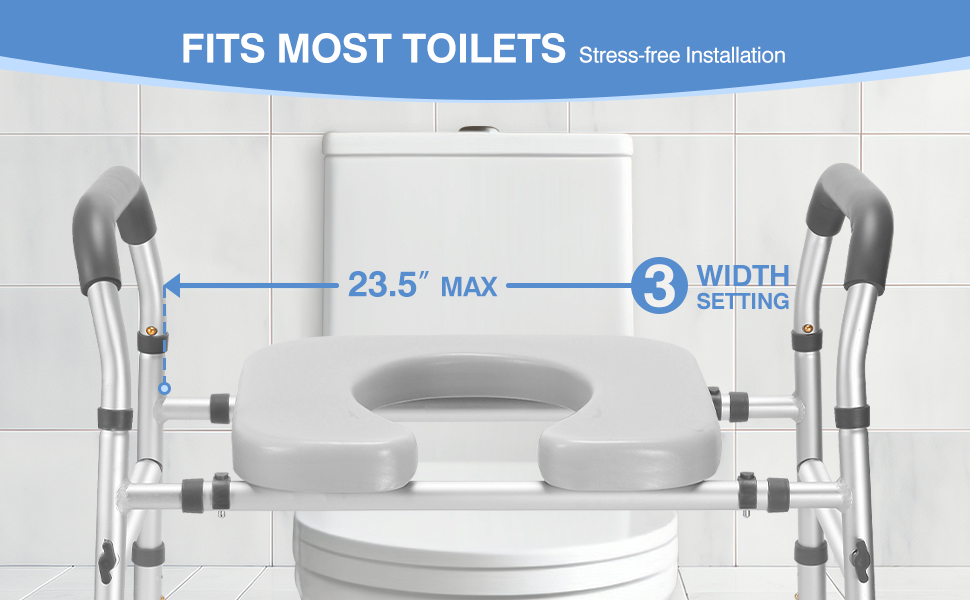
Toilet seat risers rank among the most practical assistive devices for elderly individuals who struggle with sitting down or standing up. These simple devices reduce the distance between standing and sitting positions, minimizing strain on joints and muscles during bathroom activities.
Toilet seat risers for accessibility
Toilet seat risers add height to standard toilets, typically providing an extra 2-6 inches. This elevation decreases the effort required for seniors with reduced mobility, arthritis, or those recovering from surgeries. These devices help prevent dangerous falls that commonly occur during bathroom use. Most designs feature either secure bolt-on attachments that replace existing seats or models that fit between the bowl and original seat. For shared bathrooms, hinged models fold up like traditional seats, accommodating different household needs.
Top-rated toilet risers for seniors
Several styles address different needs for 2025:
- Bolt-on risers: The Bemis Independence Assurance 3″ model stands out for stability and subtle appearance
- Clamp-on options: Dr. Maya 4″ Raised Toilet Seat offers excellent security with easy removal
- With support arms: Models from Carex provide padded handles for additional stability
The most effective risers accommodate both round and elongated toilet shapes. Bariatric versions support higher weight capacities—up to 500 pounds for specialty models versus 300 pounds for standard versions.
Toilet riser installation and cost
Installation varies by design—bolt-on models require removing the existing seat and attaching through toilet bolt holes. Portable options with anti-slip pads simply sit atop the bowl without tools. Proper installation ensures safety and prevents uncomfortable wobbling or shifting during use.
Pricing ranges from $28 for basic models to $100+ for premium versions with advanced features. Mid-range options ($40-$75) typically offer the best balance of quality and affordability, providing essential features like proper height and secure attachment mechanisms.
Glide Sheets
Glide sheets rank among the most underrated assistive devices for elderly individuals who need repositioning help. These specialized fabric sheets create a low-friction surface between the body and bed, allowing smooth movement with substantially less physical strain for caregivers.
Glide sheets for repositioning
Glide sheets primarily facilitate in-bed movements for seniors with limited mobility. The sheets reduce physical effort required by caregivers through a simple friction-reducing design. They allow gentle repositioning of patients while minimizing skin friction and shear that often leads to pressure injuries. For more independent seniors, these sheets enhance autonomy by enabling self-movement within beds.
Users employ glide sheets for various tasks including turning patients side-to-side, repositioning higher in bed, transferring between surfaces, and supporting rehabilitation activities. Research shows that despite initially taking longer to use, these sheets significantly reduce caregiver fatigue. Studies indicate a measurable reduction in work-related musculoskeletal pain when sliding sheets become standard in nursing practice.
Best glide sheets for home care
The SafetySure SlidEase features multiple hand grips for improved control during positioning at approximately $59.30. MedcoTech Patient Slide Sheets provide gentle fabric ensuring skin comfort during full-body repositioning, priced at $78.07.
Medline’s Comfort Glide Repositioning Sheets ($72.15) incorporate breathable material compatible with low air-loss mattresses. The PATRAN slide sheets offer versatility with up to 50 uses per patient across 25 different handling tasks.
Glide sheet pricing and materials
Prices range from $40 for basic models like the Skil-Care Transfer Sheets to over $300 for specialized options such as the SafetySure HT Slide with radiolucent materials. Mid-range options ($70-150) typically deliver the best value with features including handles and durable construction.
Quality glide sheets utilize low-friction materials including nylon or polyester. Premium versions feature ultra-low friction interiors combined with high-friction exteriors for stability during use. Budget-conscious buyers may consider patient-specific tubular slide sheets as more economical alternatives to reusable options.
Adjustable Hospital Beds
Adjustable hospital beds provide essential support for elderly individuals requiring extended rest or recovery periods. These specialized beds combine medical necessity with home comfort, offering crucial support for those with limited mobility.
Hospital beds for home use
Hospital beds for home use come in several distinct categories, each addressing different care needs:
- Full-Electric Beds: Feature motorized controls for head, foot, and height adjustments, allowing independent operation at $1,000-$3,500.
- Semi-Electric Beds: Offer electric head/foot adjustments with manual height control at $800-$1,800.
- Manual Beds: Utilize hand cranks for all adjustments at $500-$1,000.
- Specialty Beds: Include bariatric models supporting 350-1,000+ pounds ($2,000-$5,000+) and low beds positioned 9″-12″ from the floor ($1,200-$3,000).
These beds differ fundamentally from standard adjustable beds by incorporating medical-grade features specifically designed for patient care rather than just comfort.
Top features in adjustable beds
Key features worth considering include adjustability options that reduce caregiver back strain by 43% while improving patient comfort ratings by 78%. Head adjustments typically range from flat to 60-80 degrees, while foot adjustments offer 0-40 degrees elevation.
Selecting appropriate weight capacity remains essential—experts recommend choosing a bed rated at least 50-100 pounds above the patient’s current weight. Frame construction significantly impacts durability, with high-quality steel frames lasting 3-5 years longer than budget models.
Proper mattress selection plays a crucial role in pressure relief and comfort, with options ranging from foam to alternating air systems.
Hospital bed pricing and insurance
Complete hospital bed systems range from $600-$1,200 for basic manual beds with standard mattresses to $3,000-$10,000+ for premium systems with therapeutic mattresses. Medicare Part B typically covers 80% of approved costs after meeting the annual deductible of $257 (2025) when deemed medically necessary.
To qualify for coverage, seniors need a documented medical condition requiring a hospital bed, a doctor’s prescription with medical justification, and evidence that a regular bed is inadequate. The coverage may provide for either rental or purchase depending on expected length of need.
For those facing significant out-of-pocket expenses, options include equipment financing through suppliers, non-profit assistance programs, and state Medicaid waiver programs.
Reacher Grabbers
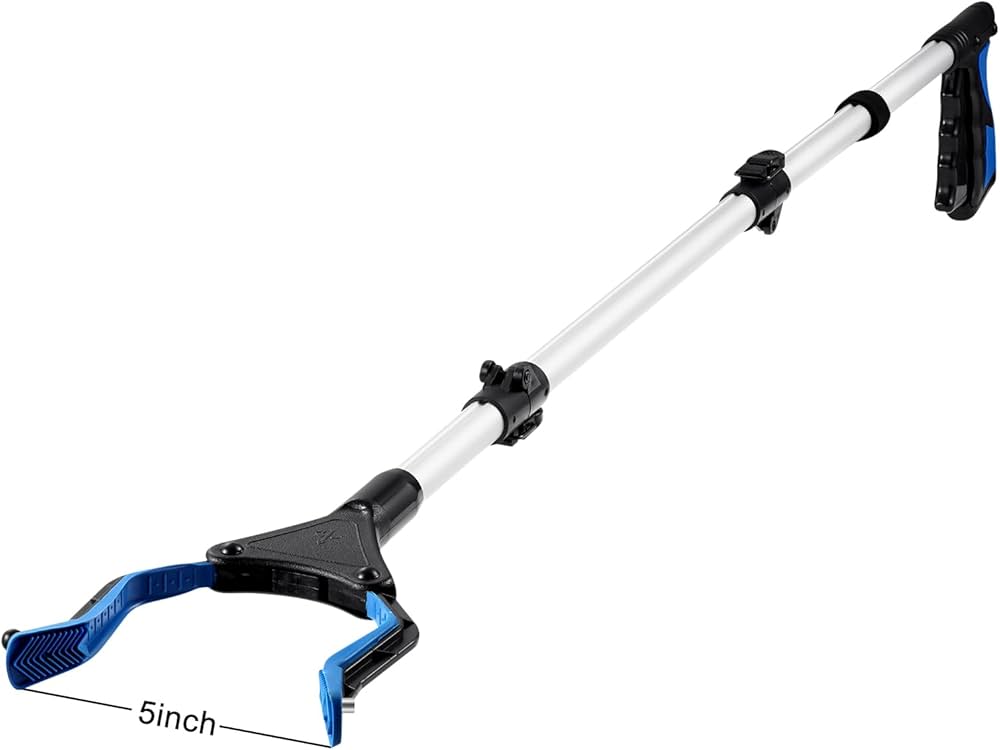
Reaching for dropped items or objects on high shelves poses surprising dangers for seniors with limited mobility. Reacher grabbers extend a person’s grasp without requiring bending, stretching, or climbing that might lead to falls.
Reacher grabbers for limited mobility
Reacher grabbers assist elderly individuals in retrieving items beyond their natural reach. These tools extend grasp by 20-44 inches depending on the model, eliminating dangerous bending or stretching movements. They function as arm extensions, featuring a trigger mechanism at one end that controls a claw or jaw at the opposite end.
Quality grabbers include specialized features for different challenges. Magnetic tips help retrieve small metal objects like keys or coins. Rotating jaws (typically 90 degrees) enable access to awkwardly positioned items. These tools benefit various conditions including post-surgery recovery, arthritis, and limited mobility.
Best grabbers for elderly independence
The RMS Health Grabber Reacher stands out with its anti-slip jaw design that securely grips even smooth objects like smartphones. The Vive Rotating Reacher Grabber earns top ratings for its lightweight aluminum construction and precision grip.
The Featherweight Original Reacher receives high scores for daily use, featuring magnetic tips and ergonomic handles to reduce hand fatigue. For seniors needing heavy-duty options, the StrongArm Reacher with 32-inch range offers a rotating jaw for vertical or horizontal use plus integrated hook mechanisms for additional security.
Grabber tool pricing and availability
Pricing varies based on features and quality. Standard models typically range from $20-$50, with premium options reaching $75-$120. Specialized models like the JAECO Orthopedic Stainless Steel Forever Reacher cost approximately $121.
Drugstores, medical supply retailers, and online marketplaces stock these devices. Physical stores typically offer limited selection compared to online options. Budget-conscious shoppers frequently find the best values through online retailers, where prices for quality grabbers start around $10-$20.
When selecting a grabber, key factors include weight (lighter models reduce fatigue), grip mechanism (rubberized jaws provide better hold), and handle design (ergonomic options benefit those with arthritis).
Comparison Table
The table below provides a direct comparison of all 15 assistive devices covered in this guide. Each device is evaluated based on price range, primary function, key features, and special considerations that might affect purchasing decisions.
| Assistive Device | Price Range | Primary Purpose/Benefits | Key Features | Special Considerations |
|---|---|---|---|---|
| Walking Sticks | $100-120 | Balance and stability support | Height adjustable (32″-54″), Flip-lock mechanisms | Suitable for users up to 6’2″ |
| Rollators | $50-500 | Mobile support with rest options | 4-wheel design, Built-in seats, Storage options | Weight capacity 250-400 lbs |
| Standard Walkers | $40-125 | Maximum stability for serious balance issues | Lightweight aluminum frame, Two-button folding | Height adjustable for 5’4″-6’2″ users |
| Canes | $25-100 | Targeted support for minimal assistance | Single-tip or quad-tip options, Various grip styles | Supports up to 25% of body weight |
| Wheelchairs | $50-15,000 | Comprehensive mobility support | Manual or powered options, Customizable seating | Medicare covers 80% if medically necessary |
| Mobility Scooters | $600-5,000 | Independent transportation | 10-45 mile range, 4-18 mph speed | Requires maintenance every 3-6 months |
| Bed Rails | $40-500 | Fall prevention during rest | Fixed or adjustable options, Swing-away arms | Proper installation crucial for safety |
| Grab Bars | Not mentioned | Bathroom safety support | Vertical, horizontal, or angled options | Must be anchored into wall studs |
| Rising Aids | $21.99-500+ | Assistance with sitting to standing | Manual or powered options, Various weight capacities | Some insurance coverage possible |
| Transfer Aids | $68-14,000 | Safe movement between surfaces | Boards, lifts, and slings available | Different types for varying mobility levels |
| Shower Chairs | $40-300+ | Safe bathing support | Drainage holes, Non-slip features | Weight capacity up to 400 lbs |
| Toilet Seat Risers | $28-100+ | Easier toilet access | 2-6 inch height increase, Various attachment methods | Available for round or elongated toilets |
| Glide Sheets | $40-300 | Easier repositioning in bed | Low-friction materials, Multiple handling options | Reusable or single-patient options |
| Adjustable Hospital Beds | $500-10,000+ | Medical-grade rest support | Electric or manual adjustments, Various positions | Medicare covers 80% if prescribed |
| Reacher Grabbers | $20-120 | Extended reach without bending | 20-44 inch reach, Magnetic tips, Rotating jaws | Consider weight and grip mechanism |
The price variations reflect significant differences in construction quality, durability, and functionality across device categories. Higher-priced options typically offer additional features that enhance comfort, ease of use, and longevity.
Conclusion
This guide examines 15 essential assistive devices that enhance elderly independence and safety. These tools range from simple walking sticks priced around $100 to sophisticated hospital beds costing several thousand dollars. Each device serves a crucial purpose—helping seniors maintain dignity while navigating daily challenges.
Assistive devices do far more than prevent falls or injuries. Fall prevention remains paramount, but these tools also restore confidence and expand possibilities for active aging. Seniors typically find their quality of life improves dramatically once they overcome hesitation about using mobility aids.
Choosing appropriate devices requires careful consideration of individual needs, physical limitations, and living environments. Consulting healthcare providers before major purchases ensures the chosen equipment properly addresses specific mobility challenges. Checking insurance coverage can make higher-priced items more accessible, especially for medically necessary equipment like wheelchairs or hospital beds.
Family members must play a supportive role in this selection process. They should approach conversations about assistive devices with sensitivity, emphasizing how these tools enable independence rather than symbolizing decline. Maintaining autonomy represents perhaps the most significant benefit these devices offer.
Assistive technology continues evolving rapidly. Newer models feature improved ergonomics, lightweight materials, and smart technology integration. Seniors today have access to better options than ever before—whether they need minimal support from a cane or comprehensive assistance from an adjustable bed.
The journey toward enhanced mobility might begin with just one device from this list. Many seniors start with simpler aids like grabber tools or shower chairs before progressing to more comprehensive solutions as needs change. This gradual approach helps both adjustment and budget management while addressing the most pressing concerns first.
